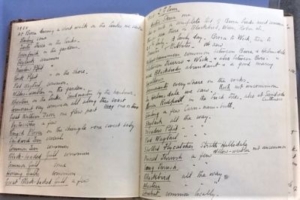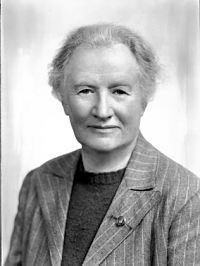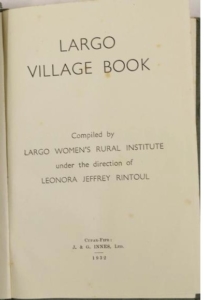Leonora Rintoul
Ornithologist
Image kindly provided by, and reproduced with permission of, the Scottish Ornithologists’ Club (https://www.the-soc.org.uk)
- BORN 2nd February 1878, Lahill, Largo, Fife, Scotland, UK
- DIED 22nd May 1953, Balsusney, Upper Largo, Fife, Scotland, UK
- WORKED Throughout Scotland, but especially the Isle of May, Fife
- HONOURS Fellow of the Royal Society of Edinburgh, 1951. (She and Evelyn Baxter were the only female Fellows of the time who were not graduates); One of the first female members of the British Ornithologists’ Union; Member of the American Ornithological Union
- MINERVA SCIENTIFICA PROJECTS Echoes fae Fife, Scottish Superwomen of Science
Entry by Catherine Booth
Artistic Connections
Together with Evelyn Baxter she collected woven baskets and encouraged traditional Scottish crafts.
She took a great interest in the history of her local village, Largo, and wrote a book about it.
While with a group of Fife women in Somerset in 1918, undertaking training for agricultural work, Leonora Rintoul was one of the performers at a concert they organised. She gave a recitation in Scots which received great applause.
Music
For: Voice and Piano
Performed by: Frances M Lynch
First performed: Aug 5th 2017, Edinburgh Festival Fringe as part of the 5 star Scottish Superwomen of Science show
“The Grey Geese” by Marie Dare (1902 – 1976), is a setting for voice and piano of a poem by C. Ethel Evans. It is performed by Frances M Lynch and was originally performed as part of an Edinburgh Festival Fringe show “Scottish Superwomen of Science”.
Title: On the Isle of May
Composer: FRANCES M LYNCH
Written: 2017
For: solo voice with accompanying female chorus and sound effects
Performed by: Frances M Lynch
First performed: 5th Aug 2017, Edinburgh Festival Fringe as part of the 5 star Scottish Superwomen of Science show
This short song gives a brief glimpse of the very rich lives of Rintoul and her fellow ornithologist, Evelyn Baxter. With the Isle of May, where they did much of their important work, at the centre of the musical material, it branches out to explore their many interests and exploits across Scotland.
Title: A Widow Bird Sate Mourning
Music by: MARIE DARE
Words by: Percy Bysshe Shelley
Written in: 1973
For: SATB Unaccompanied Choir
Performed by: Frances M Lynch, Francis St John and Herbie Clarke
First Performance: unknown
Dare was born in Fife as were the two intrepid ornithologists. This beautiful setting of Shelley’s poem could be one of those birds they wrote about after a bombardment by Zepplin on the Forth from which they noted a good many effects to the bird populations quite far from the attack. We made this recording using only 3 singers, but hopefully a choir will sing it again one day – the “good ladies” would definitely approve!
Education
Private education in her childhood, and no further formal education thereafter
Occupations
Ornithologist
Tramped around most parts of Scotland studying birds with her lifelong friend and fellow ornithologist, Evelyn Baxter.
Local historian
Her book about the history of her local area, Largo village book (1932) was well researched. A small section tells the story of Alexander Selkirk, who fled the town in 1695 following an assault on his brother. He was said to be Defoe’s inspiration for Robinson Crusoe
Agricultural labourer
Because of the need for agricultural labour during WW1, Leonora Rintoul was one of the Fife women who worked on the land planting potatoes and tending gardens. She also spent time in a camp in Somerset learning all the necessary skills to harvest flax, an industry prominent in Fife at the time
SWRI active member and organiser
Leonora Rintoul, along with Evelyn Baxter and others, founded the Largo Women’s Rural Institute in 1918, and was prominent in that body for many years
Scientific Achievements
Following collaborative research and observations, she and Evelyn Baxter produced the authoritative 2 volume work: Birds of Scotland : their History, Distribution and Migration (1953). The updated version of this work, in two large highly illustrated volumes published in 2007, extensively cites Rintoul and Baxter’s research data.
Rintoul contributed to, and published further books on ornithology and other fauna, and published many journal articles
The two women made frequent visits between 1907-1933 to the Isle of May, and made meticulous records of the birdlife. These included rare migrants and wind and weather data, making their research a unique record of that region to this day.
Various attempts were made during the 1920s and 1930s to introduce legislation to protect wild birds. Ornithologists themselves did not agree on how legislation should be framed. On one side was the Royal Society for the Protection of Birds, and on the other Scottish bird lovers including Leonora Rintoul and Evelyn Baxter. Rintoul and Baxter believed that the proposed legislation at the time would do more harm than good – that it would protect more aggressive species to the detriment of weaker and scarcer birds. Leonora Rintoul expressed these opinions strongly in letters to newspapers. Debate on the terms oflegislation continued for many years until the Protection of Birds Act was finally passed in 1954.

Rintoul’s Journal: “July 1938 At Brora during a short walk on the links we saw…” (Credit: Archive of Scottish Ornithologists’ Club)
In March 1936, both Leonora Rintoul and Evelyn Baxter were at a meeting of keen birdwatchers who decided to set up a club which would promote “the systematic recording and study of birds”. This was the Scottish Ornithologists’ Club (SOC). Both women were Joint Presidents until 1948, then Honorary Presidents. The SOC now has a membership in the thousands, and continues to flourish.
Did You Know?
Both Leonora Rintoul and Evelyn Baxter kept detailed journals of their travels and observations, and sometimes took photographs of the birds’ nests they discovered. These are retained in their archives held at the Scottish Ornithologists’ Club headquarters near Aberlady, East Lothian, and it is possible to make an appointment to view them.

Thrush Nest taken by either Rintoul or Baxter in Fife 1905 (Credit: Archive of Scottish Ornithologists’ Club)
AN INSPIRING WOMAN
Although they travelled round Scotland extensively themselves, Leonora Rintoul and Evelyn Baxter also looked to others to help them collect data on birds from different parts of Scotland. Nowadays we would be putting messages on Twitter; they sent letters to newspapers like the Scotsman, asking people to send them details on particular birds they may have observed. Examples included requests for information for a census of herons in February 1928, and on sightings of waxwings in November 1946 during an immigration of these birds. Records suggest that women in particular often responded to these requests, and subsequently signed up to be bird recorders.
Both Rintoul and Baxter were always very encouraging and supportive to anyone new to bird observation. Their publications continued to instruct in ornithology long after their deaths.



